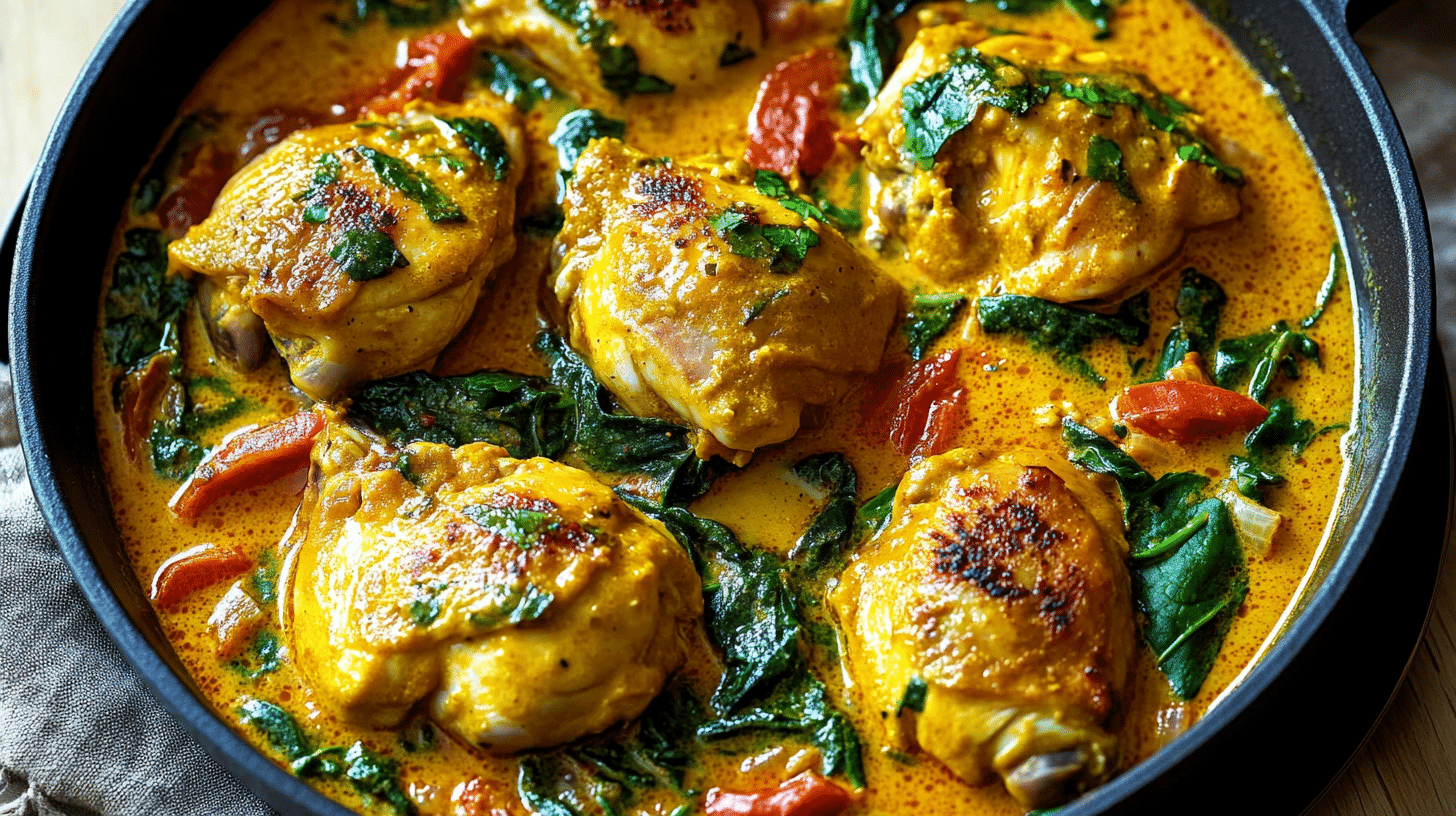This One-Pot Coconut Thai Chicken Curry is a flavor-packed and incredibly comforting meal that’s surprisingly easy to make! Tender chicken (thighs or drumsticks are great here) is simmered in a rich and aromatic coconut milk broth infused with Thai red curry paste, turmeric, and other fragrant spices. I love how this recipe comes together mostly in one pot (or Dutch oven suitable for the oven), minimizing cleanup while maximizing flavor. It’s perfect for a weeknight dinner or a cozy weekend meal. Get ready to enjoy the vibrant tastes of Thailand!
Why You’ll Love This Thai Chicken Curry
- Rich and Flavorful: The combination of coconut milk, Thai red curry paste, fish sauce, and spices creates a complex and delicious flavor profile.
- Tender Chicken: Slow cooking the chicken in the sauce makes it incredibly tender and juicy.
- One-Pot Meal: Most of the cooking happens in one pot, making cleanup easier.
- Easy to Make: This recipe uses simple ingredients and straightforward instructions.
- Customizable: You can easily adjust the spice level and ingredients to your liking.
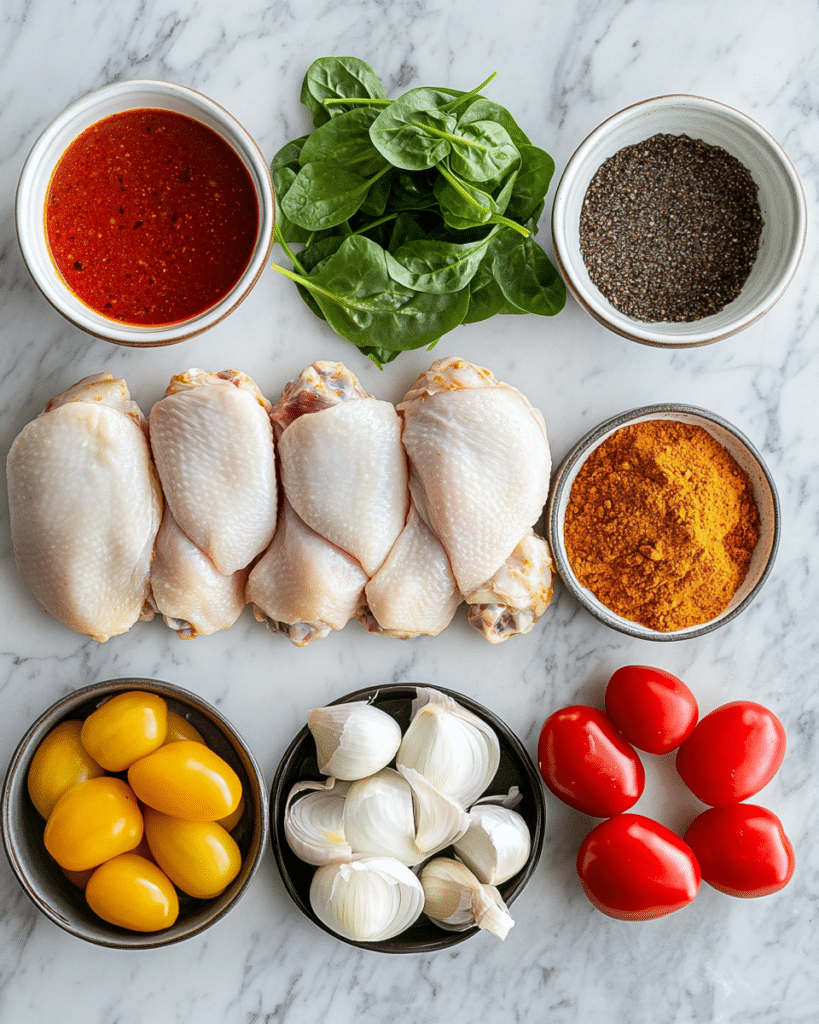
Ingredients for Coconut Thai Chicken Curry
Here’s what you’ll need to make this flavorful dish. The full list with measurements is in the recipe card below.
Main Ingredients
- Olive oil (Oil)
- Onion, sliced (Vegetable)
- Bone-in, skin-on chicken thighs or drumsticks (Meat)
- Turmeric (Spice)
- Curry powder (Spice Blend)
- Thai red curry paste (Spice Paste) See notes in original recipe
- Plum tomatoes, chopped (Vegetable)
- Unsweetened coconut milk (canned, full-fat) (Dairy Alternative)
- Fish sauce (Condiment)
- Brown sugar (Sweetener)
- Cilantro, roughly chopped (Herb)
- Spinach (optional) (Vegetable)
Seasoning
- Kosher Salt
For Serving
- Cooked Jasmine or Basmati Rice
(Note: the full ingredients list, including measurements, is provided in the recipe card below.)
Variations
I love this Coconut Thai Chicken Curry as is, but here are a few ideas for variations:
- Different Protein: Use boneless, skinless chicken, shrimp, tofu, or beef instead of bone-in chicken. Adjust cooking times accordingly.
- Add More Vegetables: Toss in some bamboo shoots, bell peppers, green beans, or sweet potatoes.
- Make it Spicier: Add more Thai red curry paste or a pinch of cayenne pepper.
- Different Curry Paste: Try using green curry paste or yellow curry paste for a different flavor profile.
- Add Lime: Squeeze some fresh lime juice over the finished dish for extra brightness.
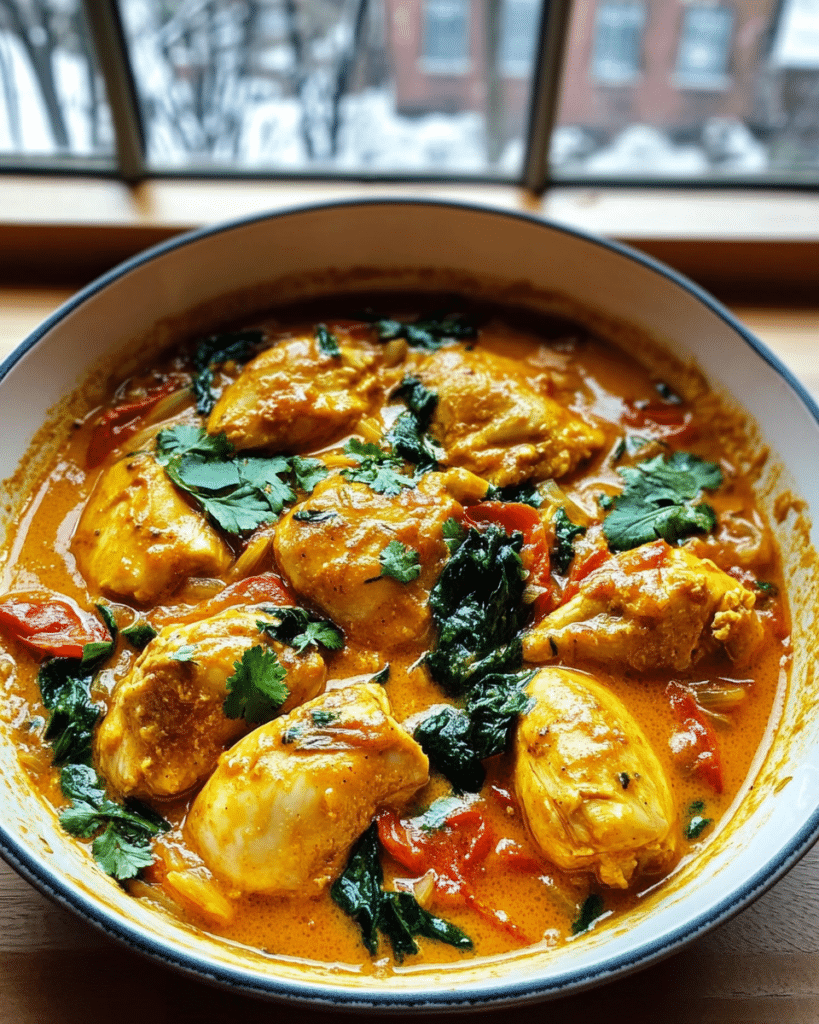
How to Make Coconut Thai Chicken Curry
Let me show you how easy it is to make this One-Pot Coconut Thai Chicken Curry:
Sauté Onions
- I heat the olive oil in a large sauté pan (oven-safe, like a Dutch oven) over high heat.
- I add the sliced onions and a pinch of salt.
- I immediately turn the heat to medium-low. I stir every so often and cook until the onions soften and begin browning at the edges, about 5 minutes.
Season Chicken
- Meanwhile, I place the chicken in a large bowl and season it all over generously with kosher salt. (I use about 1 teaspoon per pound).
Add Spices and Tomatoes
- I add the curry powder, turmeric, and Thai red curry paste to the onions in the pan.
- I stir until the onions are coated in the spices, about a minute.
- I add the chopped tomatoes and stir until they just begin to soften, about another minute.
Add Liquids and Simmer
- I add the can of coconut milk.
- I fill up the empty can of coconut milk with water and add that to the pan.
- I add the fish sauce and brown sugar and bring the mixture to a simmer. (Note: The original recipe mentions potential issues with too much liquid; this version uses less water than some previous iterations).
Add Chicken and Bake
- I add the chicken pieces to the pan and turn them to coat in the sauce.
- I transfer the pan (uncovered) to the preheated oven at 400ºF (200°C).
- I cook for 1 hour, or until the liquid has reduced considerably, the chicken skin is brown, and the meat is falling off the bone. If the liquid has reduced too much, I add more water by the quarter cup. (Note: If I make this ahead, I might need to add more water upon reheating.)
Finish and Serve
- I add the chopped cilantro and stir.
- If I’m using spinach, I add it now and stir until wilted.
- I spoon rice into bowls.
- I top with the chicken and sauce.
- Serve immediately
Tips and Tricks for the BEST Thai Curry
Here are my secrets for making this curry truly exceptional:
- Use Bone-In, Skin-On Chicken: Bone-in, skin-on chicken adds more flavor to the curry and stays juicier during cooking.
- Adjust Curry Paste: Thai red curry pastes vary in heat level. Start with the recommended amount and add more if you like it spicier.
- Full-Fat Coconut Milk: Full-fat coconut milk creates the richest and creamiest broth.
- Don’t Overcook the Chicken: Cook the chicken until it’s tender and falling off the bone.
- Fresh Cilantro: Fresh cilantro adds a bright, herbaceous flavor that complements the curry perfectly.
How to Serve
This Coconut Thai Chicken Curry is delicious served with:
- Jasmine or Basmati Rice: The classic accompaniment to soak up the flavorful sauce.
- Rice Noodles: Another great option for serving.
- Naan Bread: Perfect for dipping into the curry sauce.
- Garnishes: Top with extra cilantro, lime wedges, chopped peanuts, or sliced red chili.
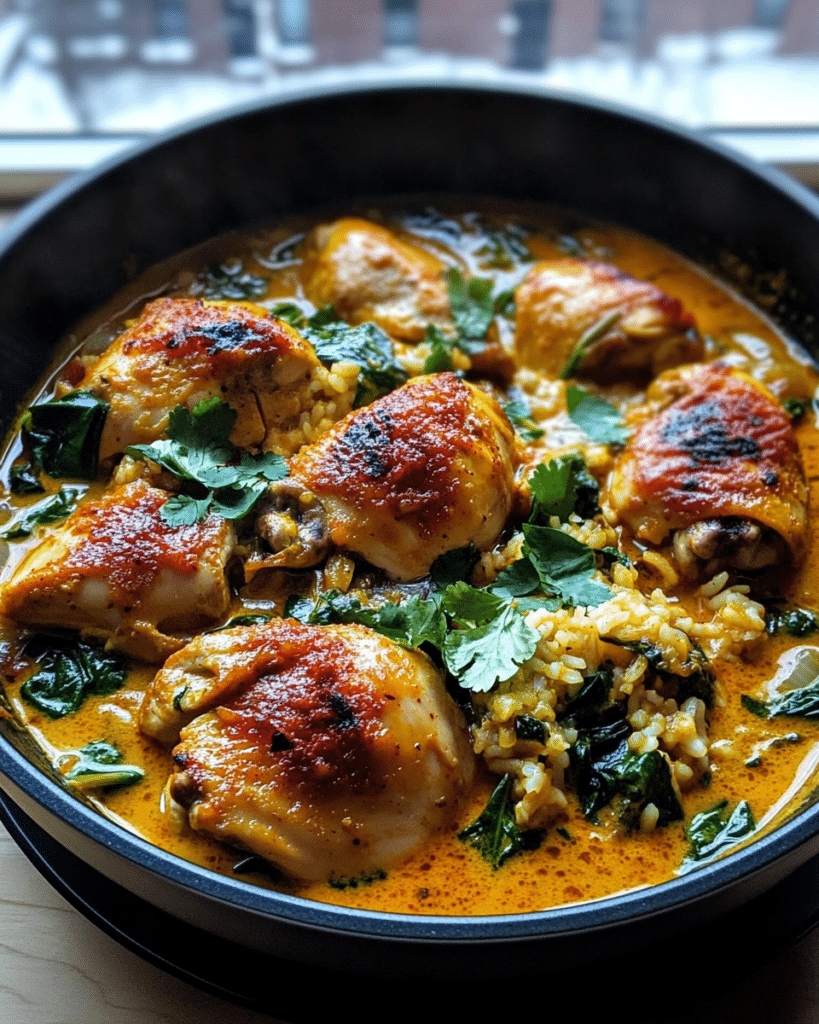
Make Ahead and Storage
This curry tastes even better the next day! You can store leftovers in the refrigerator for up to 3 days. Reheat gently on the stovetop or in the microwave. You can also freeze this curry for up to 3 months.
FAQs about Coconut Thai Chicken Curry
- Can I use chicken breasts instead of thighs/drumsticks?
- Yes, you can use boneless, skinless chicken breasts. Cut them into bite-sized pieces and add them during the last 20-30 minutes of cooking time to prevent them from drying out.
- Can I make this vegetarian/vegan?
- Yes! Use vegetable broth, substitute tofu or extra vegetables for the chicken, and use a vegan fish sauce alternative or additional soy sauce/tamari.
- Where can I find Thai red curry paste and fish sauce?
- You can find these ingredients at most well-stocked supermarkets or Asian grocery stores.
Enjoy this rich, flavorful, and easy-to-make One-Pot Coconut Thai Chicken Curry! It’s a perfect meal for any night of the week.
Print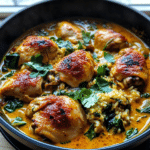
One-Pot Coconut Thai Chicken Curry
- Prep Time: 15 minutes
- Cook Time: 1 hour 10 minutes
- Total Time: 1 hour 25 minutes
- Yield: 4-6 1x
- Category: Main Course
- Cuisine: Thai
Description
This Easy, One-Pot Coconut Thai Chicken Curry is a flavorful and comforting dish. Bone-in chicken thighs or drumsticks are simmered in a rich and aromatic coconut milk broth infused with Thai red curry paste, turmeric, curry powder, tomatoes, and fresh herbs.
Ingredients
- 1 tablespoon olive oil
- 1 large yellow onion, sliced
- Kosher salt, to taste
- 8 bone-in, skin-on chicken thighs or drumsticks (or a combination)
- 2 teaspoons ground turmeric
- 2 teaspoons curry powder
- 1–3 tablespoons Thai red curry paste (adjust to your spice preference, see notes)
- 3–4 plum tomatoes, chopped
- 1 (13.5-ounce) can full-fat unsweetened coconut milk
- 1 can (use the empty coconut milk can) water (or low-sodium chicken broth, see notes)
- 1 tablespoon fish sauce
- 2 teaspoons brown sugar (light or dark)
- 1/2 cup fresh cilantro, roughly chopped, plus more for garnish
- 3–5 ounces fresh spinach (optional)
For Serving (Optional):
- Cooked Jasmine or Basmati rice
Instructions
- Preheat Oven: Preheat your oven to 400°F (200°C).
- Sauté Onions: Heat the olive oil in a large, oven-safe sauté pan or Dutch oven over high heat. Add the sliced onions and a pinch of salt. Immediately reduce the heat to medium-low. Cook, stirring occasionally, until the onions soften and begin to brown at the edges, about 5 minutes.
- Season Chicken: While the onions are cooking, season the chicken pieces generously on all sides with kosher salt.
- Add Spices and Tomatoes: Add the curry powder, turmeric, and Thai red curry paste to the onions in the pan. Stir constantly for about 1 minute, until fragrant and the onions are coated in the spices. Add the chopped plum tomatoes and stir until they just begin to soften, about another minute.
- Add Liquids: Pour in the can of coconut milk. Fill the empty coconut milk can with water (or chicken broth) and add it to the pan. Add the fish sauce and brown sugar. Stir well to combine and bring the mixture to a simmer.
- Add Chicken: Add the seasoned chicken pieces to the pan, turning them to coat them in the sauce.
- Bake (Uncovered): Transfer the pan uncovered to the preheated oven. Bake for 1 hour, or until the liquid has reduced considerably, the chicken skin is browned, and the meat is cooked through and tender (falling off the bone is ideal). Note: The internal temperature of the chicken should reach 165°F (74°C).
- Adjust Liquid (If Needed): If the liquid reduces too much during baking, add more water or broth, 1/4 cup at a time.
- Add Cilantro and Spinach (Optional): Remove the pan from the oven. Stir in the 1/2 cup of roughly chopped fresh cilantro. If using spinach, add it now and stir until it wilts.
- Serve: Spoon cooked rice into bowls. Top with the chicken pieces and generously spoon the sauce over the top. Garnish with additional fresh cilantro, if desired. Serve immediately.
Notes
- Thai Red Curry Paste: The amount of curry paste determines the spice level. Start with 1 tablespoon for mild heat and increase to 3 tablespoons for more spiciness, depending on the brand and your preference.
- Chicken: Bone-in, skin-on chicken thighs or drumsticks add the most flavor to the dish. You can use boneless, skinless chicken, but reduce the baking time accordingly (check for doneness after 20-25 minutes).
- Water vs. Broth: Using water (measured in the empty coconut milk can) is traditional, but you can substitute low-sodium chicken broth for extra flavor.
- Sauce Consistency: The sauce will thicken slightly as it cooks. If it becomes too thick, add more water or broth. If you make this ahead, you may need to add more water upon reheating.
- Fish Sauce: Fish sauce adds a characteristic salty, umami flavor to Thai dishes.
- Make-Ahead: This curry can be made ahead of time and reheated gently on the stovetop or in the oven. You may need to add more water or broth when reheating.
- Storage: Store any leftovers.

